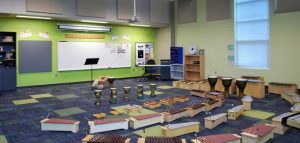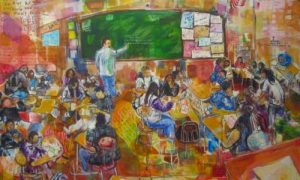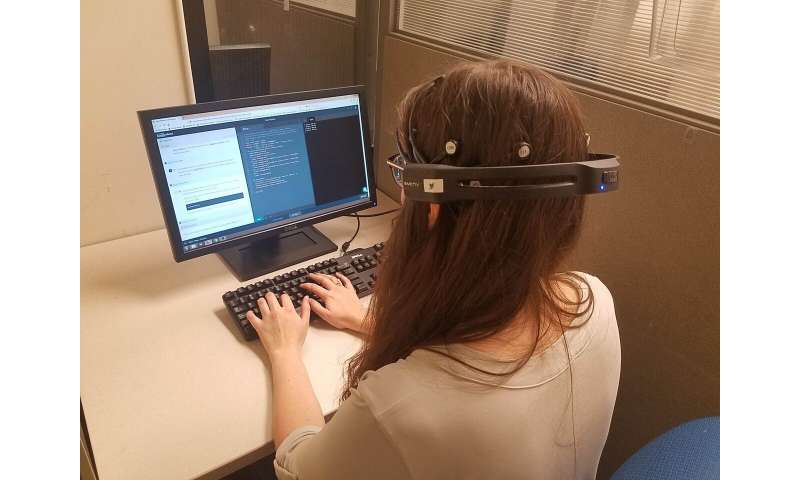Role of technology in education – As we embark on the Fourth Industrial Revolution, it’s clear that technology will play a central role in nearly all aspects of our lives. Research by the World Economic Forum estimates that 65% of children entering primary school will find themselves in occupations that today do not exist.

1.5 Million Digitized Jobs
By 2020 it’s estimated there will be 1.5 million new digitized jobs across the globe. At the same time, 90% of organizations currently have an IT skills shortage, while 75% of educators and students feel there is a gap in their ability to meet the skills needs of the IT workforce. To prepare the talent needed for the digital economy, education must adapt as fast as the demand for IT skills is growing and evolving.
Insights into the influence of psychological, social, cultural and environmental factors on how we learn are emerging from “the new science of learning”. This approach to understanding education argues that in our complex and rapidly evolving world today, academic models based on interdisciplinary research are necessary to create effective teaching and learning environments.
Technology and Education
Although technology is finally being integrated into education, its use for teaching and learning still remains a challenge. Despite the fact that many schools today are privileged to have ready access to technology, trained teachers, and a favourable policy environment, the use of technology in the classroom is still low. Some attribute low levels of technology use in education to the pedagogical beliefs of teachers.
With that said, the potential of technology to enhance learning cannot be overemphasized. The use of technology is something that started a long time ago for students with special needs. For example, brail machines have been utilized for the visually impaired. In addition, special needs programs that help children with autism use technology to enhance learning. By integrating technology into education, educators aim to engender pedagogical change and address fundamental issues that affect learners with special needs. Technology can therefore be seen as both a tool and a catalyst for change.
To narrow it down, we came up with 10 reasons for the importance of technology in education:
Students demand it.
Students are engaging with technology constantly outside of the classroom. Kids like to be interactive, and learning through technology has now become a part of their lifestyle.
New teachers are demanding it.
The technology movement has been implemented in post-secondary education as well as other professional jobs. For new teachers, technology is considered a necessity for the learning environment.

Kids are the digital native.
Kids know technology better than most adults. It has become the easiest way they learn, because it is such an integral part of their life. Engaging with technology in the classroom has not only helped them learn better, but they also acquire multi-tasking skills. At this day in age, they hardly know how to learn without it. This knowledge is important, because they would be way behind in the real world without it.
Kids can learn at their own pace.
We know from years of experience that kids learn at their own pace, but sometimes the traditional classroom makes it difficult to do so. With the integration of technology in education, children have the ability to slow down and go back over lessons and concepts, and more advanced kids can go ahead. It also frees up the teacher to help kids on a more one-on-one level.
With technology, there are no limitations.
Having access to other information outside of the book gives students many different ways to learn a concept. Teachers can come up with creative ways to teach their students that keeps them engaged. Technology has changed the learning environment so that learning is more hands-on. Schools throughout the nation are diverse in income, and often kids don’t always get the resources they need. The implementation of technology in schools helps close that gap.
Technology has the ability to enhance relationships between teachers and students.
When teachers effectively integrate technology into subject areas, teachers grow into roles of adviser, content expert, and coach. Technology helps make teaching and learning more meaningful and fun. Students are also able to collaborate with their own classmates through technological applications.
Testing has gone online
One protocol that schools don’t have control over, but must adapt to, is online testing. Testing online is the way of the future, but it has a lot of advantages. Technology can instantly assess the students’ performance. Beyond seeing test scores in real-time, teachers can better track and understand students’ grasp of the subject.
Multitude of resources
Computers, tablets, and other forms of technology bring multiple resources for the teacher that’s not in the book. They not only keep students engaged with exciting new features and apps, but also have other ways to teach students material. Every kid learns differently, and technology helps with this gap as well.
Technology keeps kids engaged.
The students of this generation are considered technological learners. They learn best being more interactive, and technology is what helps them do that. Children often struggle to stay on task or interested, and with resources to help the teacher, they can better stay focused and learn faster.
Technology is necessary to succeed outside of primary and secondary education
Whether we like it or not, technology is an essential concept to learn. Because it changes so quickly, children are better off learning about it sooner. It is a primary part of every industry, and there is no way around it. These days, technology means more than just learning basic computing skills. Technology has made itself part of every aspect of our lives today, and the students who understand it are the ones who succeed in the business world.
Learn more about this topic by reading this article on the World Economic Forum .
After reading “Role of technology in education” you can check important issues for ESL teachers on the section PDFs, and visit my YouTube channel.











